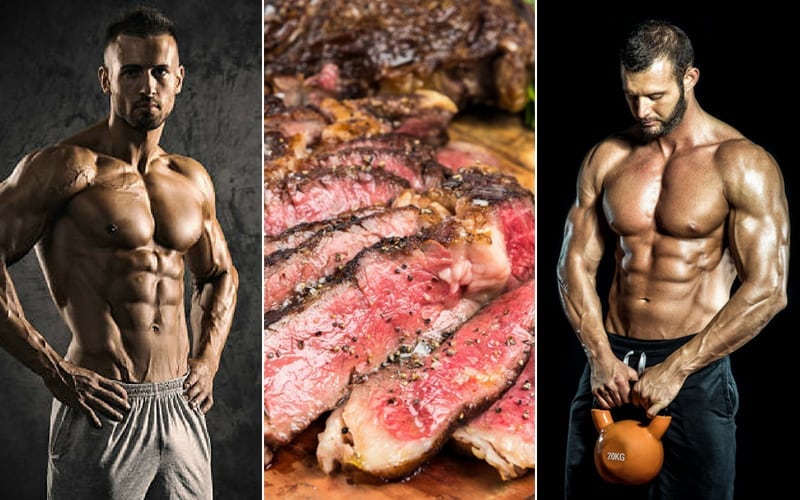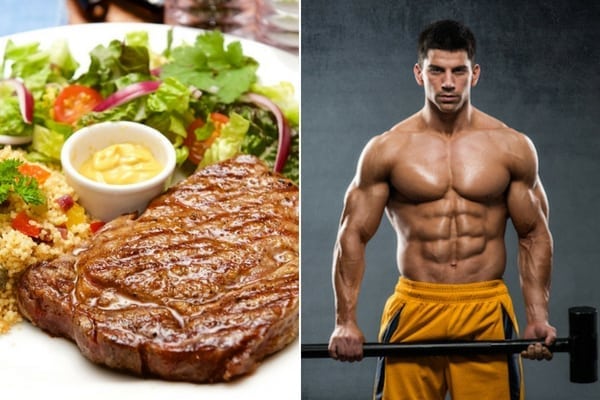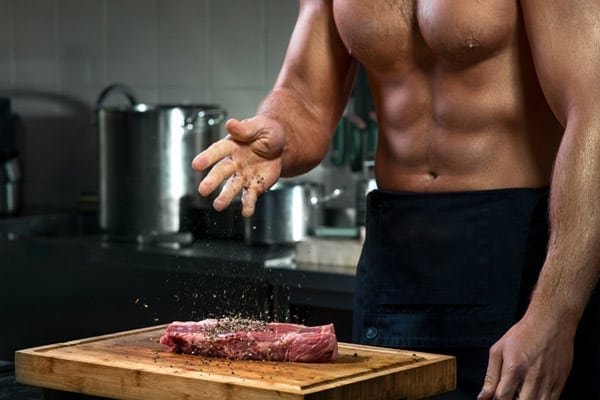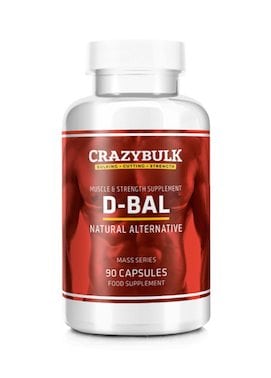No products in the cart.
Anabolic Diet Guide for Muscle Gains & Fat Loss

The Anabolic Diet is a diet created by Dr Mauro Di Pasquale, a physician and competitive powerlifter from Ontario, Canada.
This is a low-carbohydrate diet that includes alternating low-carb and high-carb days. It was named the Anabolic Diet as it is believed that its use could mimic the effects of anabolic steroids.
Please continue reading to find out more about this diet, and whether it will be of benefit to your own training efforts.[toc]
What are Cyclic Ketogenic Diets (CKDs)?
This diet is a CKD, which means that it focusses primarily on periods of low-carb dieting that are then followed by brief “carb loading” phases designed to restore your glycogen levels.
Most ketogenic diets like this are low in carbohydrates, with most involving high protein and fat consumption. This causes your body to turn to fat for energy, as your glycogen stores are low.
How Does the Anabolic Diet Work?

According to the creator of this diet, Dr Di Pasquale, when you alternate your carbohydrate intake you are allowing your body to burn more fat as fuel while helping to maintain as much muscle mass as possible.
A typical diet would include all three major macronutrients; carbs, protein and fat. This diet is a little different as 5 days of the week there will be almost no carbs consumed, while the remaining 2 will be used to essentially binge on carbs.
To maintain muscle mass your body needs calories, so it is good to hear that this diet does not involve any calorie restriction.
Benefits of the Anabolic Diet
The potential benefits of the Anabolic Diet include [1]:
- Fat Loss – As your body is forced to burn fat for energy for 5 days your overall body fat percentage will drop.
- Muscle Gains – Red meat is a key ingredient of this diet. It contains testosterone boosting cholesterol and saturated fats.
- Better Health – It has been shown that the Anabolic Diet can help lower both cholesterol and triglyceride levels, can help reduce plaque build-up, cut food allergies and reduce acne.
- More Energy – Fewer carbs will help reduce the amount of low blood sugar crashes you experience, plus the bloating and heaviness experienced after a carb-heavy meal.
- Less Hunger – Fat is filling, helping to ensure that you stay fuller for longer.
Phases of the Anabolic Diet
There are three phases of the Anabolic Diet: Induction, Bulking and Cutting.
Induction Phase
The purpose of this phase is to get your body ready for this diet.
It will last for 1-4 weeks and you should try to consume your maintenance calorie intake. You can work this out by multiplying your body weight in pounds by 18.
There are other methods you can use to work out your maintenance calorie intake, but this is the method Dr Di Pasquale recommends.
While your body adapts to this diet you can expect to experience stomach issues, moodiness and tiredness.
Bulking Phase
During the bulking phase, you may need to adjust your calorie intake depending on the results you experience.
According to Dr Di Pasquale during this phase, you will find your ideal body weight in pounds and then add 15% extra to that number.
For example, if you wanted to weigh 180 pounds you would need to bulk until you reached 207 pounds.
To achieve this goal you would aim to consume 20-25 calories per pound of the desired body mass (20 calories x 207 pounds = 4,140 calories daily).
If you are gaining more than 2 pounds a week then you should reduce the number of calories consumed. You should increase the calories if you are not seeing an increase in body weight.
Cutting Phase
This particular phase is similar to the maintenance phase, except this time you are going to be dropping your calorie intake.
Dr Di Pasquale suggests dropping your daily calorie intake by 500-1000 calories.
As with the bulking phase, you are allowed to adjust your calorie intake if you are losing weight too quickly or too slowly.
Anything over 2 pounds a week is too extreme and will likely result in muscle mass being lost, something you most likely do not want to occur. You should aim to lose around 1 pound a week.
While the phases of this diet have different calorie goals, the macronutrients required for the Anabolic Diet remain the same throughout.
This diet is split into two timeframes:
Weekdays
You should try to avoid carbs during the week, instead, you should focus on proteins, fats and vegetables (40% protein/60% fat with a maximum of 25 grams of carbs).
Weekends
On the weekends you are allowed to binge on carbs, this means lowering your protein and fat intake. Aim to consume 15% protein, 25% fat and 60% carbs to help refill your glycogen stores.
Potential Risks of the Anabolic Diet
There are benefits to be gained from this diet, however it is not recommended for long term use.
The reason for this is that this diet may not necessarily be healthy as there are essential nutrients missing from it.
One of the primary drawbacks is that there is very little fruit, vegetable and legume intake, which can lead to a lack of fibre being consumed. A lack of micronutrients may also be an issue.
This lack of essential nutrients is bad as they are needed to combat the oxidative stress created through exercise.
A lack of fibre can also cause an increase in unhealthy gut bacteria and constipation.
More worryingly is that studies [2] have shown that high-fat, keto diets like this cause insulin resistance, which will cause your risk of heart disease, type 2 diabetes and metabolic syndrome to increase.
Food Choices for the Anabolic Diet

While on the Anabolic Diet there are certain go-to foods you should eat, these include:
- Red meat like beef and pork are must-haves, as they are full of protein and cholesterol. These will help fuel your muscle gains and give you that much-needed energy boost.
- Poultry is also a good option, although it is less fatty than red meat. Chicken and turkey will add a little variety to your meal plan.
- Fish are another good option as they contain protein and omega-3 fatty acids. Fatty fish like salmon and herring will help promote the breakdown of fat and will help boost testosterone levels.
- Eggs are another great protein choice and should become a staple of your meal plan. Other dairy products like cheese is also important as it contains both protein and saturated fats.
- Nuts are a good snack food option, as they contain protein and healthy fats. Make sure to carry some nuts around with you to ensure these are what you choose when peckish.
- Vegetables should be added to every meal, with green veggies all-important due to their fibre content, which will help with digestion.
- Fruits are best avoided while on your non-carb days, however, they are a good option of the weekends when carbs are allowed.
When choosing carbohydrates it is best to opt for cleaner ones, such as unprocessed, whole-grain carbs. The reason for this is that they will leave you lees sluggish and lethargic.
Anabolic Diet FAQs
The following are questions that are often asked about the Anabolic Diet:
Can a vegan try the Anabolic Diet?
Yes, however, this diet may be hard for vegans as the low-carb phase will involve consuming a high protein diet, which can sometimes be an issue for those who do not consume animal protein.
What supplements can be taken while on the Anabolic Diet?
You can pretty much take any supplement while on this diet, however, it is best to avoid using mass gainers or other supplements with a high carb content during the low-carb days.
Will the Anabolic Diet give me “steroid-like” muscle gains?
No, unfortunately not.
Is this diet safe for those with high cholesterol?
I would recommend speaking to your doctor or a health professional before starting any new diet.
What can I do about the bloating and lethargy encountered on carb days?
To reduce this I would recommend increasing meal frequency so that you are better able to distribute the carbs consumed.
Is it normal to feel sluggish during the induction phase?
Yes, this is normal while your body adjusts to this diet.
In Conclusion: Would We Recommend the Anabolic Diet?
This diet is definitely not one for those not dedicated, as not only is there calorie counting to contend with but you will also need to ensure you are hitting those macros too.
For some having to cut carbs will leave them feeling lethargic and unhappy, and this low-carb diet is definitely not for those who regularly take part in sports where carb intake is important.
If you, however, are looking for a way to build muscle and lose fat, and are willing to stay dedicated throughout then this may be just the diet plan to choose.
Remember while your diet choice is important for muscle growth and fat loss it is not the only aspect you need to concentrate on.
Your training is also important, as well as the supplements you use. I would recommend that when bulking that you try to limit your cardio while concentrating on weight training 3-4 times a week minimum.
When you are cutting you can introduce some cardio into your training.
As for supplementation, those offered by Battle Ready Fuel are a good choice for the basics (whey protein, creatine and BCAAs etc), but there are other options available too to give you that little extra training boost.
 One particular supplement brand we do recommend is Crazy Bulk, a brand that sells a range of legal steroids. These include the popular Dianabol alternative D-Bal.
One particular supplement brand we do recommend is Crazy Bulk, a brand that sells a range of legal steroids. These include the popular Dianabol alternative D-Bal.
D-Bal is made from ingredients that include Whey Protein Concentrate, Tribulus Terrestris and various BCAAs. These will help boost strength and muscle by increasing nitrogen retention and protein synthesis.
The benefits of D-Bal include:
- Muscle and strength gains
- More endurance, ensuring you are able to workout longer
- Improved nitrogen retention
- Better blood flow, making sure that extra oxygen is sent to your muscle tissue
If you have any doubt about these claims then I would suggest that you visit the Crazy Bulk website. They have a number of user testimonials available that back up these claims.

How many calories should I eat while on steroids?
I would recommend you read the following guide to see how many calories you should be eating to build muscle. 🙂